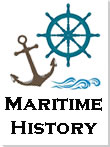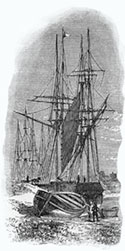Maritime History of Newport
By Peter Brown
© Peter Brown 2024
Smuggling
Newport is fortunate to have detailed records of the area's smuggling history. This is because the Customs Collector in 1932, J. W. Dawson, wrote a book called Commerce and Customs: A History of the Ports of Newport and Caerleon. Due to his access to all the official records, this book provides a detailed account of the history of local smuggling until the end of the 19th century. The book is out of print but can be accessed online.[1]
Since duty was first applied to imported goods in the Medieval period, efforts have been made to circumvent payment of duty owed to the Government, and this practice still survives in different forms. Smuggling refers to transporting illegal goods and violating applicable laws or other regulations. In the case of ports, this usually refers to importing foreign-produced goods into the port discretely or perhaps by unloading in hidden creeks or inlets away from public view.
Smugglers often worked in large groups, and those involved included a range of people across the community who played different roles in the complex processes involved with funding, coordinating, importing, concealing and distributing the contraband articles.[2]
The details of smuggling activities in the Newport area, as elsewhere, are necessarily limited due to the clandestine nature of the work and the need to limit records and evidence. Our fragmentary information comes mainly from official Customs records, so we are fortunate to have Dawson’s detailed account.
Smuggling was rife in the western ports in the 14th century, and in 1387, the Mayor of Bristol was directed to investigate English smugglers running goods into Wales.[3] An early example of smuggling was the merchant William Jones of Caerleon, whose Bristol-owned ship, the Trinity of Caerleon, was actively smuggling between 1539 and 1550.[4] With a capacity of between 180 and 200 tons, she was a frequent visitor to Spain and Portugal, bringing back oil, wine and grain; other trips involved leather, alum, fish, lead and cloths. The evidence suggests that Jones combined smuggling with the regular cargoes.
Due to the relatively small size of the typical trading ships in the later 16th century, there were many more places for docking in Monmouthshire than the rivers Usk and Wye, so the Customs authorities needed to be vigilant to prevent smuggling. The smuggling craft varied in size but typically had fore-and-aft rigging. Unlike craft with square sails, which need wind coming from behind, fore-and-aft-rigged vessels can manoeuvre by tacking, enabling them to adapt and turn to depart quickly. This made them ideal for the needs of smugglers.[5]
More early evidence of smuggling survives from 1565, when James Rosser of Caerleon, yeoman, imported nine tuns of Gascon wine worth £9 into Newport. The following year, Thomas James, a tanner of Caerleon, was caught smuggling wine from Portugal. Henry Morgan, H.M. Controller of the ports and creeks of counties of Monmouthshire and Glamorganshire, acted against George Herbert, Esq. – and some glovers, shoemakers and others – who were wrongfully importing from overseas to diverse ports and creeks in the said counties of Monmouthshire and Glamorgan. The merchandise was valued at 2000 marks (£1333), and no duty had been paid. Herbert was also accused of menacing Morgan when required to pay duty on his imported wines.[6]
The Deputies appointed to Newport in 1578 were Roger Williams (the Mayor), Morgan Griffith, Lewis Thomas, William Phillip, William Williams and John ap Morgan. The Customs accounts at Newport and Caerleon were controlled by Henry Morgan (the General Customer and Collector of the port of Cardiffe), and the Comptrollers were David Roberts, William Wood, John Millom and Edward Jordan.[7] At this time, David Roberts was accused of “receiving the Pyratts and theyr spoyles.” Another – John Millom – was fined £200 by the Star Chamber for “misdemeanors and offences” and was also “to be sett twice upon the Pyllory, once at the open Sessions or Assizes and another tyme upon a m’kett day at the towne of Cardiffe.” A third Comptroller for Newport – Edward Jordan – was challenged over “Babary hides” seized in Cardiff and incarcerated in the Town Prison. It appears that in addition to fighting the smugglers, the government also had to deal with corruption from their officials.[8]
A Special Commission at Newport in 1578 identified the various “havens, creeks and landing places” in the county so that deputies could be appointed to control them for the Customs accounts managed by the General Customer and Collector of the port of Cardiff. The havens were listed as follows, with Caerleon presumably being classed with Newport as it is also on the Usk inlet:[9]
* Rompney haven or creek
* Peterstone creek called the great Goulte
* Westhowe creeke
* Ebothy creeke or pyll
* Newport
* Chepstow
* Caldycott, Sidbrooke, Collystreeis creeks or pylls
* Matharne, Saynt Peare, and Pull Meirck is creeks or pylls
* Aberwaythelles creek or pyll
* Gouldclyff creek
* Easterlyhowcke creek
* Traston and Cyllan Howes creek
* Jenkyn Lewys and Wentlandes creek.
We are fortunate to have detailed records of the 17th-century Customs operations in the region kept by John Byrd of Caerleon, who was Collector of Customs for the port of Cardiff from 1635 to 1662. For this service, he was paid £30 per year plus “rydeinge charges” as Collector and £10 per year as Comptroller.[10] These records provide a fascinating look at his life and work, in a job that put him in confrontation with others who sought to evade payments due. An example of this was on 9 September 1649, when Byrd wrote the following from Caerleon:[11]
The 7th of this moneth I seazed on 34 great rowles and 14 hand rowles of Barbathoes tobaccoe which was privately landed at Redwick. The tobacco was about 2000 lb weight, which was the goods of Thomas Northerne, Sam Roche, Wm. Turkey and others of the shipp Elizabeth and Ann of Bristoll, and it was landed with an intent to defraude the State of Custome and Excise.
A year later, the Commissioners received details of more contraband tobacco that landed at Newport from France, brought by a ship called the North Star.[12]
In 1768, the ship Moderator was investigated for smuggling. This was the first of several ships of that name associated with the Moderator Wharf, which stood where the Riverfront Theatre now stands. The Officers discovered two small packs of wool on the ship – weighing 212lb – which had not been declared. The ship was detained, and it appeared that a farmer shipped the wool without the knowledge of the Captain, Abraham Jones, who had a good record for his fair trade with Bristol. Eventually, the Commissioners condemned the wool and released the vessel.[13] Two years later, Officers made a further discovery at Newport when they found 12 brandy casks (about 96 gallons) in a barn.[14]
In 1784, smugglers landed at Goldcliff in a sloop with 12 hogsheads of quality tobacco (weighing 9804 lb), all finely cut, and a cask with 40 gallons of brandy. The Customs Officers missed the contraband but found it later in an outhouse owned by William Waters. The Collector at Cardiff was informed and directed that it be taken to Newport under armed guard owing to the significant presence of smugglers. The tobacco was later taken to Cardiff and burnt. Waters was acquitted at the enquiry on the evidence suggesting that none of the cargo was intended for his benefit. Two months later, a boat was seized at Goldcliff with 130 gallons of rum and brandy.[15] It was suspected that the cargoes belonged to the well-known smuggler Thomas Knight, who had established a formidable base at Barry Island in 1783, from where his large band of smugglers conducted their business and fought the authorities. He was dislodged from there in 1785 and transferred to Lundy.[16]
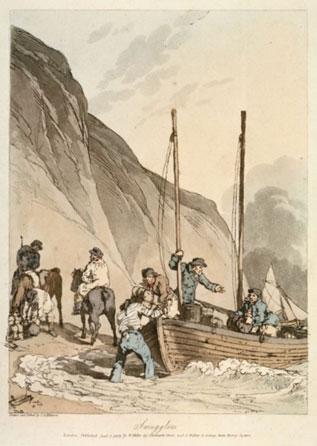
Smugglers, by John Augustus Atkinson (1808)
Reproduced from Wikimedia Commons.[17]
.
The Goldcliff case is also interesting because we have the account for the incidental expenses concerning the seizure:[18]
|
£ |
s. |
d. |
Six waggons at £1 1s. 0d. |
6 |
6 |
0 |
Ale to waggoners and helpers, Goldcliff |
|
2 |
6 |
Justice’s clerk, Francis’ deposition |
|
1 |
0 |
Helpers |
|
5 |
0 |
Turnpikes and waggons, Newport |
|
8 |
0½ |
Waggoners eating and ale |
|
6 |
4 |
People for assistance |
|
9 |
6 |
Storehouse, Night guards, their expenses |
2 |
7 |
0 |
Turnpikes, waggons, Stow Gate |
|
6 |
10 |
Guarding waggons at Cardiff |
2 |
5 |
0 |
Ale and eating on road |
|
4 |
0 |
Waggons to Cardiff |
6 |
6 |
0 |
Turnpikes at Rumney and Cardiff |
|
16 |
0 |
Weighing coopers |
|
9 |
0 |
Paid for ale for people assisting taking out of cellar |
|
7 |
10 |
Haulage to place of burning |
8 |
12 |
0 |
Tea barrels and wood for burning |
1 |
1 |
0 |
Paid for kiln |
|
12 |
0 |
Cellar rent |
3 |
3 |
0 |
Drawing indenture |
1 |
7 |
6 |
Two months later, there was a further seizure at Goldcliff involving a boat with 139 gallons of rum and brandy.[19]
An interesting case in 1791 illustrates the dangers involved in the work of the Revenue Officers when a smuggling skiff of 15-20 tons with an open hold was intercepted while at anchor at the mouth of the Usk. The smugglers threatened the Officer with a cutlass and pistol, saying that if he came on board, they would blow his brains out. There were “six or seven desperate ruffins on board”, and the vessel was described as new and in red and black, with The John of Comb on the stern. The Officers believed she was built for smuggling and belonged to the pirate base on Barry Island. The report requested that the Commissioners provide a small cutter to be stationed at Penarth and available to assist Officers in the Channel.[20]
In 1804, the Collector of Customs reported that “the running of goods up the river Usk has of late been frequently attempted and sometimes with success as we are assured.” The amount discovered was small, but 172 gallons of rum were seized on the schooner Hopewell of Bridgwater. Between 1827 and 1830, seizures at Newport were mainly small quantities of Irish Whiskey brought over in cattle boats from Cork, Youghal and Clonakilty. From the 1830s onwards, the discovery of contraband increased in quantity, variety and importance.[21]
In August 1830, the Master of the brig Prince Regent reported that his dutiable stores consisted of only 6 gallons of rum, 2 gallons of brandy and 2 gallons of gin. That night, a 20-year-old crew member came ashore with a cask and a jar and walked into a Customs Boatman called Edward Frost, who was John Frost’s cousin. Frost was suspicious and, on examination of the vessel, discovered that the cask with 6 gallons of rum contained 18 gallons. The young sailor was sentenced by the Police Court to serve 5 years in the Navy.[22] A year later, a carpenter from the same ship was found carrying 6 pounds of tobacco ashore hidden in clothes. He was also required to serve 5 years in His Majesty’s Navy instead of imprisonment.
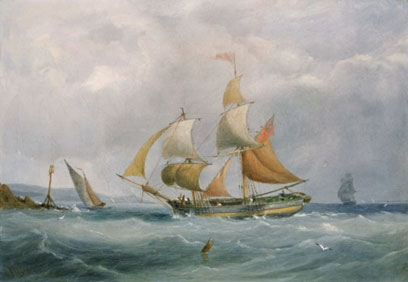
A trading brig entering the Bristol Avon, by Joseph Walter (1838)
Image from the Royal Museums Greenwich, reproduced by kind permission under a Creative Commons licence.
On 22 June 1833, the schooner Kate of Bristol was anchored off Nash Point when two fishermen observed (at night) the transfer ashore of spirits into an empty house. When the Custom House was informed, the Comptroller, Mr John Smith Phillips, visited the house with three Boatmen and seized 252 kegs containing about 1100 gallons of brandy. A further eight casks containing 40 gallons were discovered hidden in a ditch. All the seized goods were taken to the King’s Warehouse. On board the Kate, the Comptroller found a jar containing 2½ gallons of brandy and a keg with 1½ gallons of cherry brandy. The empty house had been rented by a publican in the neighbourhood who stated that he sublet it to “a stranger”, who was never identified. However, the vessel was released without conclusive proof that the spirits had been landed from the Kate. For some time afterwards, cheap rum was available in the area, while the seized goods were held for 10 months in the King’s Warehouse before being shipped to St Katherine’s Dock in London.[23]
At Newport, the 72-ton schooner Good Intent was owned by a consortium of five of the town’s businessmen, one of whom had strong links with the revenue services. The ship plied a perfectly innocent trade with France, but when passing through Mount’s Bay (Cornwall) in 1837, a revenue cruiser inspection revealed that the captain’s and merchant owners' intents were far from good. The schooner had false bulkheads concealing 1100 gallons of brandy in 259 small kegs. The ship was cut up, and the Master was sentenced to a long spell in Monmouth's gaol. Significantly, the owners simply lost their ship.[24]
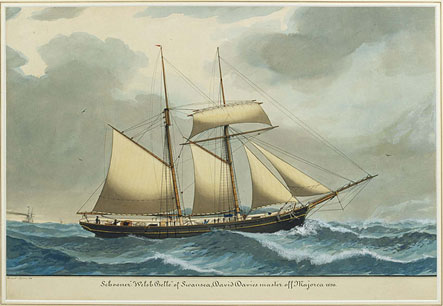
Painting of the 'Schooner Welsh Belle of Swansea, David Davies master, off Majorca 1890', by Luigi Renault of Leghorn, 1890 (watercolour on paper).
This gives a good idea of the schooners smuggling goods at Newport in the 19th century.
Reproduced by the kind permission of Swansea Museum under the Creative Archive Licence.
In 1839, the schooner Swift of London came up the Usk and anchored about a mile from the Custom House. The Customs Officers searched the vessel the next day and found 2½ tons of manufactured tobacco, 150 lbs of snuff, and 1104 lbs of Nux Vomica (an Asian tree used for medication). The vessel was forfeited, and the Master and one crew member were sentenced to 6 months in Monmouth Gaol in default of payment of a £100 fine each.[25]
The following year, The Customs Boatman Edward Frost visited a coal yard at night, where he discovered 170 kegs of brandy. Suspicion fell on the schooner Henrietta of Plymouth, where Frost and two colleagues found 154 kegs of brandy, totalling 1056 gallons, hidden under the ballast.[26]
The owners of the coal yard were engaged in another attempt to run a contraband cargo in 1841 when the schooner Rose, a Newport vessel, was anchored at the mouth of the river Ebbw. Frost and other Officers made a surprise night visit and discovered 118 casks of brandy on the shore, a waggon, and two carts with five horses ready to take the goods away. Two further brandy casks were discovered concealed in the hold of the Rose. Correspondence found on the Master implicated her former owners, the proprietors of the coal yard, and a man at St Mellons, well known in the smuggling trade. Frost also found the former owners on the bank near the schooner, with their clothes covered with river mud. They were heavily fined, and the Master and crew were imprisoned. The horses and vehicles had been borrowed from a local farmer and publican but were also forfeited. The Commissioners arranged for the Rose to be broken up like the Swift and Henrietta mentioned above.[27]
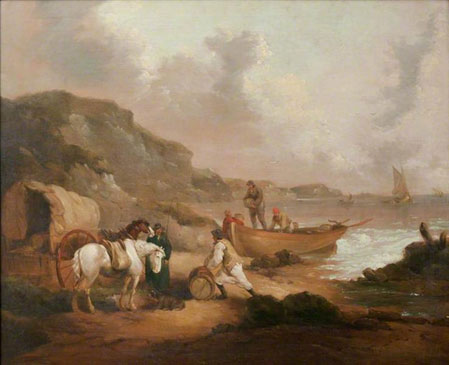
Smugglers on a Beach (1793), by George Morland (1763-1804).
In the public domain at Wikiart.[28]
In August 1846, a cask containing 25 gallons of foreign brandy was found concealed in a house in Newport, but days before the hearing, the occupier moved out to Bristol, where he was later found and convicted.[29]
Also in 1846, the Robert Burns, a snow (similar to a brig) of 286 tons, was at Newport. At 10:00 p.m. on 29 October, three men were seen leaving the ship with a box covered with a cloth, which they took to a house in Pillgwenlly. An official visit allowed a seizure of 134 lbs of manufactured Cavendish tobacco. The Master quickly left and sailed for Bermuda.[30]
The Police assisted the Customs Officers on some occasions. In 1849, two policemen discovered two seamen walking towards town, carrying bags containing 112 lbs of tobacco.[31] In 1867, a hawker was arrested for stealing a firkin of butter from Mr Matthews’ warehouse in Skinner Street. Searching his lodgings, they discovered a trunk containing 70 lbs of manufactured Cavendish tobacco and a small quantity of unmanufactured tobacco. Two hobblers of Pillgwenlly were carrying a parcel on the evening of 2 December 1868 when the Police were sufficiently suspicious to question them. The men said they were carrying cheese, but the Police found it was Irish rolled tobacco.[32]
The lengths that smugglers used to conceal contraband were often ingenious. In one case, a skipper placed a heavy sofa to screen a sliding panel which covered a recess containing spirits. In another example, an innocent-looking case containing hams from Denmark had 10 lbs of tobacco and 300 cigars underneath. A pigeon coup with a false bottom was also used as a receptacle for contraband. These efforts were cleverer than the Master of a French vessel discovered at Newport with 3½ lbs of tobacco inside his trousers![33]
In 1854, the schooner Chateaubriand arrived in ballast from an Irish port. According to her clearing note, the stores left under seal were 14 lbs of tobacco, 1½ lbs of cigars and 14 gallons of wine. The Customs Officer found that the seal had been removed from the tobacco bag, which was empty, and the Master explained that the contents had been distributed to the crew. When the Officer instructed the Master to collect all the tobacco from the crew, the result was 24 lbs. A further search revealed one cask and one demijohn containing 19 gallons of rum.
A later reference to smuggling (1896) can be found in the catalogue of The National Archives as a “request for information by the Governor of Newfoundland in respect of a British ship suspected to have carried undeclared goods from Newport, co Monmouthshire.”[34]
As long as there have been Customs checks at Newport, there has been smuggling, and as long as there has been smuggling, there have been tales of successes and failures, all adding to the colourful folklore of Newport’s maritime heritage.
References
1 Dawson, J. W. (1932) Commerce and Customs: A History of the Ports of Newport and Caerleon, Newport: R. H. Johns.
Online at: https://archive.org/details/commerce-and-customs-newport
2 Platt, Richard (2007/2011) Smuggling in the British Isles: A History, Stroud: The History Press, Chapter 2.
3 Dawson, 88.
4 Gray, M. and Morgan, P. (2009) The Gwent County History, vol. 3, The Making of Monmouthshire, 1536–1780, Cardiff: University of Wales Press, 246-7, citing E. T. Jones, The Bristol Shipping Industry.
5 Platt, 35.
6 Kennerley, E. (1979) ‘River Trade and Shipping in Caerleon from the 16th to the 19th Century’, Gwent Local History, 47.
Online at: http://www.caerleon.net/archive/literature/glh/47river.htm
7 Dawson, 14.
8 Dawson, 14-15.
9 Dawson, 13-14
10 Dawson, 27.
11 Dawson, 91.
12 Dawson, 91.
13 Dawson, 46.
14 Dawson, 92
15 Dawson, 92-3.
16 Platt, 194; Dawson, 92-3.
17 https://commons.wikimedia.org/wiki/File:Smugglers_by_John_Atkinson.jpg
18 Dawson, 93.
19 Dawson, 93.
20 Dawson, 94.
21 Dawson, 94.
22 Dawson, 95.
23 Dawson, 95-6.
24 Platt, 138.
25 Dawson, 96-7.
26 Dawson, 97.
27 Dawson, 97.
28 https://www.wikiart.org/en/george-morland/smugglers-on-a-beach
29 Dawson, 98.
30 Dawson, 98.
31 Dawson, 98.
32 Dawson, 98.
33 Dawson, 98-9.
34 TNA CUST 46/105
Back to Index of Peter Brown's "Maritime History of Newport "
